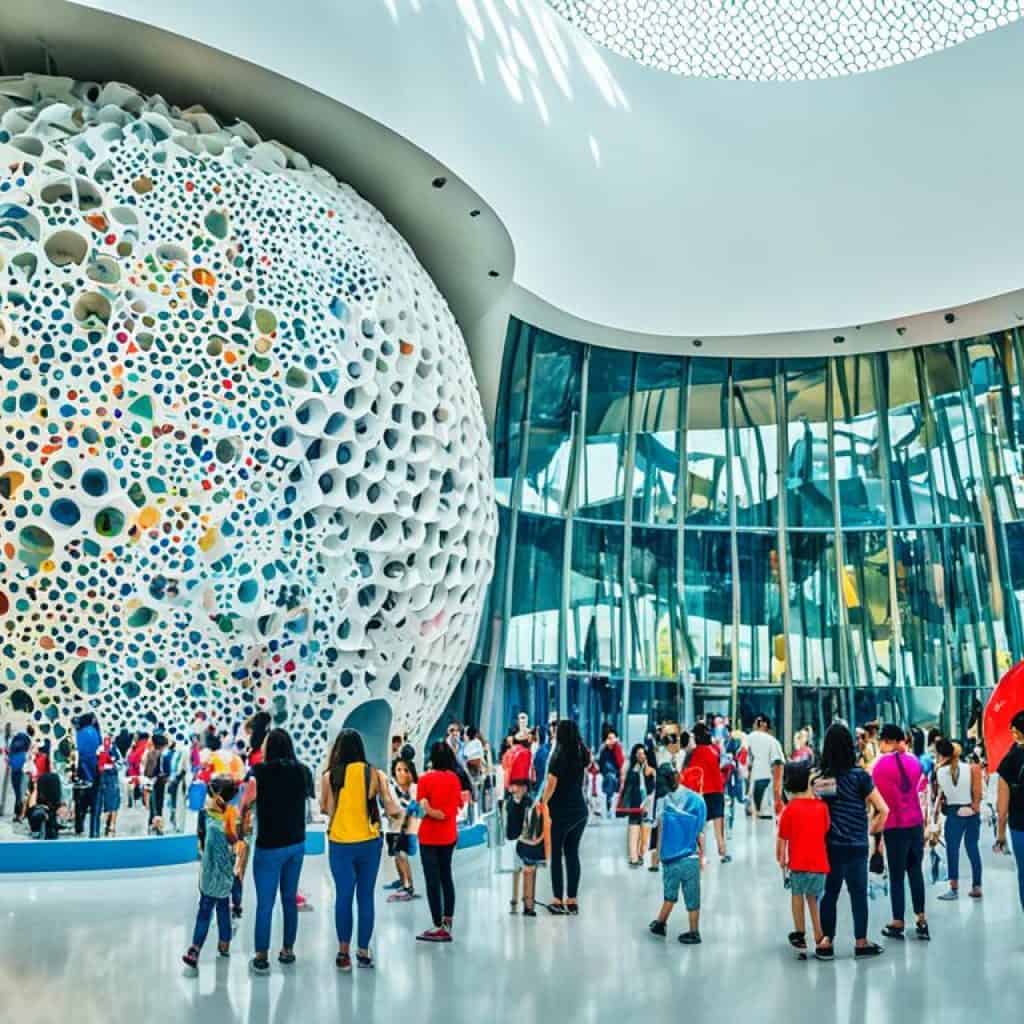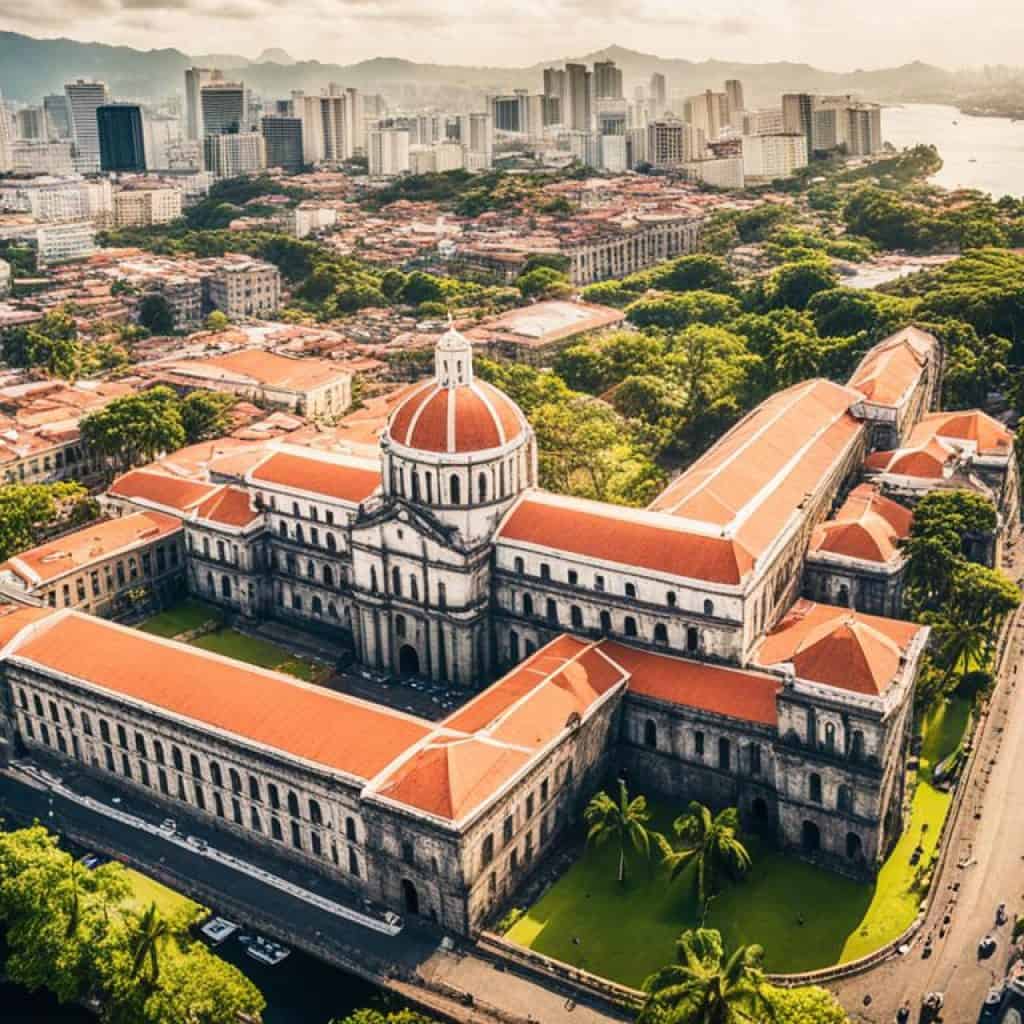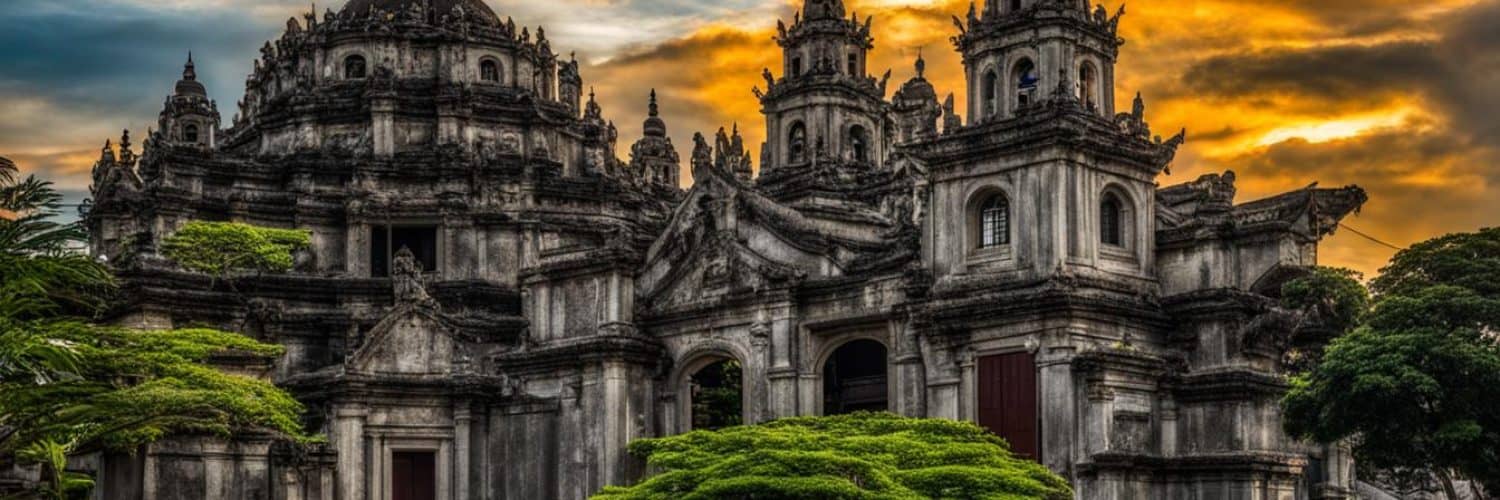The Philippines is known for its stunning beaches, but did you know that it is also home to a rich architectural heritage? From iconic buildings to historical structures, the Philippines offers a diverse range of architectural landmarks that are not to be missed. Whether you’re an architecture enthusiast or simply appreciate the beauty of well-designed structures, the Philippines has something for everyone. So, what are some of the famous architecture in the Philippines that you should definitely explore?
In this article, we’ll take you on a virtual tour of the country’s most famous architectural sites, from contemporary designs to traditional Filipino architecture. We’ll uncover the work of renowned architects and showcase the blend of influences that have shaped the architectural landscape of the Philippines. Get ready to be inspired and discover the hidden gems that await you in this beautiful country.
Key Takeaways:
- Explore the famous architecture in the Philippines, from iconic buildings to historical structures.
- Discover the blend of influences that have shaped the architectural landscape of the country.
- Learn about renowned architects and their contributions to Philippine architecture.
- Experience the beauty of traditional Filipino architecture and modern designs.
- Plan your architectural tour of the Philippines and uncover the country’s architectural gems.
Zuellig Building, Makati
Situated in the heart of Makati City, the Zuellig Building is a modern marvel of architecture. This 155-meter high skyscraper stands tall, showcasing its contemporary design and innovative use of modern technologies. The building’s environmentally conscious design has earned it recognition as a leader in sustainable architecture.
With its sleek and elegant facade, the Zuellig Building is a statement of contemporary design. Its towering presence adds to the city’s skyline, making it a prominent landmark in Makati. The use of glass panels and clean lines creates a visually striking aesthetic that blends harmoniously with the surrounding cityscape.
What sets the Zuellig Building apart is its commitment to environmentally conscious design. It was the first building in the Philippines to receive the Platinum certification level by the Leadership in Energy and Environmental Design (LEED), a globally recognized standard for sustainable buildings. The building incorporates various energy-efficient features, such as efficient lighting systems, rainwater harvesting, and advanced cooling systems, reducing its environmental impact.
The Zuellig Building combines contemporary design, modern technologies, and an environmentally conscious approach, setting a new standard for skyscrapers in Makati.
While visitors cannot enter the building, the exterior alone is a sight to behold. The unique architectural design draws attention from passersby and captures the imagination of architecture enthusiasts. Its sleek and timeless aesthetic stands out amidst the bustling city, making it a must-see attraction for anyone visiting Makati.
Key Features of the Zuellig Building:
- Contemporary design that complements the city landscape
- Innovative use of modern technologies
- Environmentally conscious design
- Platinum LEED certification for sustainable architecture
The Zuellig Building embodies the spirit of contemporary design and serves as a testament to the integration of modern technologies and environmentally conscious practices in architecture. Its presence in Makati’s skyline is a symbol of the city’s progress and commitment to sustainable development.
| Building Name | Location | Design Style | Technological Innovations | Environmental Features |
|---|---|---|---|---|
| Zuellig Building | Makati | Contemporary | Incorporation of modern technologies | Platinum LEED certification for sustainable design |
The Ruins, Talisay, Negros Occidental
The Ruins in Talisay, Negros Occidental, is a mesmerizing testament to a tragic past. What remains today is the skeletal frame of a once magnificent ancestral mansion, which was ravaged by fire during World War II. Despite the destruction, The Ruins continues to captivate visitors with its poignant beauty and exquisite Italianate architecture.
The Ruins was originally built by a wealthy sugar baron named Don Mariano Ledesma Lacson in the early 1900s. With its opulent design and grandeur, the mansion stood as a symbol of the Lacson family’s prosperity. However, during the war, it was deliberately set on fire by the family to prevent it from being used as a headquarters by the Japanese army. The mansion was so well-constructed that even after the fire, its solid skeletal structure remained, showcasing the resilience of its Italianate architecture.
Today, The Ruins stands surrounded by beautifully manicured lawns, offering visitors a serene and picturesque setting. The imposing columns and arches, reminiscent of ancient Roman architecture, evoke a sense of nostalgia and admiration. As you explore the grounds, you’ll be transported back in time, imagining the lavish parties and opulent lifestyle that once filled these halls.
“The Ruins is a hauntingly beautiful reminder of the past, allowing visitors to step into history and appreciate the artistry and craftsmanship of the bygone era.” – Architecture enthusiast
The Italianate architecture of The Ruins is characterized by its symmetrical design, intricate details, and graceful proportions. The mansion’s facade features ornate Corinthian columns, decorative reliefs, and arched windows that exude elegance and sophistication. Inside, the remnants of the mansion reveal glimpses of the past, giving visitors a glimpse into the lavish lifestyle of the Lacson family.
Visiting The Ruins is a truly remarkable experience. As you walk through the remnants of this ancestral mansion, you can’t help but be awestruck by its grandeur and the stories it holds. Whether you’re an architecture enthusiast, history buff, or simply someone who appreciates beauty, The Ruins in Talisay, Negros Occidental, is a must-visit destination.
| Highlights of The Ruins | Location | Architectural Style |
|---|---|---|
| Ancient ruins of a grand ancestral mansion | Talisay, Negros Occidental | Italianate architecture |
| Impressive skeletal structure with intricate details | ||
| Surrounded by beautifully manicured lawns | ||
| Evoke a sense of nostalgia and admiration |
The Mind Museum, Taguig
The Mind Museum in Taguig is a futuristic building that stands out with its unique design inspired by cellular structures and growth. This landmark work earned international recognition for taking science into a fully experiential world. Visitors can spend hours exploring its 250 science galleries and exhibits, making it a must-visit for architecture enthusiasts and science lovers alike.

| Key Features | Highlights |
|---|---|
| Futuristic Design | A building inspired by cellular structures and growth |
| Interactive Science Museum | 250 science galleries and exhibits to explore |
| Experiential World of Science | A fully immersive and engaging museum experience |
| Perfect for All Ages | A place where learning and fun come together |
The Mind Museum is a testament to the boundless possibilities of futuristic design and its integration with educational experiences. So, if you’re looking for a unique architectural and scientific adventure, the Mind Museum is definitely worth a visit!
San Agustin Church, Manila
The San Agustin Church in Manila is a remarkable architectural masterpiece that stands as one of the most prominent religious buildings in the Philippines. Constructed in the 16th century, this magnificent church exemplifies the early Baroque style, blending Spanish and Chinese influences into a harmonious design.
The San Agustin Church features a symmetric Latin cross plan, with a stunning facade adorned with intricate ornamentation. The interior is equally captivating, with exquisite frescoes adorning the walls and a wealth of religious relics on display, transporting visitors to a bygone era.
“The San Agustin Church is a true gem of early Baroque architecture, combining elegant elements from Spanish and Chinese styles to create a captivating atmosphere of spirituality and awe.” – Architectural Enthusiast
Recognized for its historical and cultural significance, the San Agustin Church has been designated as a UNESCO World Heritage Site, further highlighting its importance as a national treasure. Its enduring beauty and architectural brilliance make it a must-visit destination for tourists and architectural enthusiasts alike.
Calle Crisologo, Vigan
Calle Crisologo in Vigan is a street that will transport you back in time. As you step onto this historic street, you’ll find yourself surrounded by enchanting colonial architecture that has been beautifully preserved from the 18th century. This street, located in the Spanish colonial town of Vigan, offers visitors a glimpse into the rich heritage and history of the Philippines.
As you stroll along the cobblestone streets, the charm of Calle Crisologo will captivate you. The rustic mansions, with their distinct Spanish colonial design, stand as a testament to the grandeur of a bygone era. The antique wooden doors, adorned with intricate carvings, tell stories of the town’s rich history and cultural heritage.
Immerse yourself in the vibrant ambiance of Calle Crisologo, where the past seamlessly blends with the present. The street comes alive with colorful horse-drawn carriages known as calesas, providing a nostalgic mode of transportation and a unique way to explore the area. The scent of local delicacies wafting through the air and the sound of traditional music add to the festive atmosphere of this historic street.
Experience the Timeless Beauty
Take a step back in time and embrace the timeless beauty of Calle Crisologo. Whether you are an architecture enthusiast or simply looking to immerse yourself in the history and culture of the Philippines, a visit to this charming street is a must.
| Main Attractions | Highlights |
|---|---|
| Preserved Colonial Mansions | Admire the well-preserved colonial mansions that line the street, showcasing exquisite Spanish colonial architecture. |
| Antique Wooden Doors | Take in the intricate details of the antique wooden doors that adorn the mansions, each telling its own unique story. |
| Horse-Drawn Carriages | Experience a nostalgic ride on a colorful calesa, a traditional horse-drawn carriage that adds to the old-world charm of the street. |
| Local Delicacies | Treat your taste buds to delicious local delicacies offered by the streetside vendors, and savor the flavors of the Philippines. |
Intramuros, Manila
Intramuros, the historic center of Manila, is a fortified city surrounded by ancient walls dating back to the 16th century. This walled city is filled with architectural gems that represent the country’s colonial past, including Fort Santiago Fortress and Casa Manila Museum. Exploring Intramuros offers visitors a chance to step back in time and appreciate the centuries-old history and architecture of the Philippines.

One of the main attractions within Intramuros is the iconic Fort Santiago Fortress. This historic landmark stands as a reminder of the Spanish colonial period and its architectural design showcases a fusion of Spanish, Chinese, and Filipino influences. Visitors can wander through the fort’s intricate passageways, explore its museum, and even walk along the famous Rizal Shrine, dedicated to the national hero Jose Rizal.
Another architectural gem within Intramuros is the Casa Manila Museum. This beautifully restored Spanish colonial house offers a glimpse into the opulent lifestyle of the elite during the colonial era. With its grand courtyard, exquisite furniture, and ornate decor, Casa Manila Museum transports visitors back in time to the elegance and charm of the past.
Intramuros is not just a haven for history enthusiasts, but also for architecture lovers. The combination of Spanish colonial and Filipino architectural influences make this fortified city a unique destination for those seeking to appreciate and understand the historic architecture of the Philippines. From intricately designed churches and government buildings to charming cobblestone streets, Intramuros offers a captivating journey through the country’s architectural heritage.
Leandro Locsin – The Most Famous Architect in the Philippines
Leandro Locsin, a renowned architect in the Philippines, is celebrated as one of the most influential figures in the field. His visionary designs have left an indelible mark on the country’s architectural landscape, with iconic structures that continue to captivate and inspire.
Locsin’s most notable works include the Cultural Center of the Philippines and the Philippine International Convention Center. These buildings serve as shining examples of his innovative approach to architecture, combining form and function to create awe-inspiring spaces that have become cultural landmarks.
The Cultural Center of the Philippines, located in Manila, is a true testament to Locsin’s mastery. This architectural masterpiece encompasses multiple performance venues, including theaters, galleries, and exhibition halls. Its striking design, featuring a sail-like roof and sweeping curves, harmoniously blends with the surrounding environment, creating a captivating visual spectacle.
The Philippine International Convention Center, also situated in Manila, exemplifies Locsin’s commitment to pushing boundaries and reimagining spaces. This iconic structure showcases his signature style of incorporating geometric shapes and clean lines to create a sense of grandeur and modernity.
| Architectural Masterpiece | Location | Key Features |
|---|---|---|
| Cultural Center of the Philippines | Manila | Distinctive sail-like roof, sweeping curves, multiple performance venues |
| Philippine International Convention Center | Manila | Geometric shapes, clean lines, sense of grandeur |
Leandro Locsin’s architectural genius continues to shape the landscape of the Philippines, inspiring future generations of architects. His visionary designs, manifesting in iconic structures like the Cultural Center of the Philippines and the Philippine International Convention Center, have become pivotal in defining the country’s architectural identity.
Juan Nakpil – The First National Artist of Architecture in the Philippines
Juan Nakpil, a Filipino architect, holds the distinction of being the first recipient of the National Artist of the Philippines award for his exceptional contributions to the field of architecture. Known for his modernist style and innovative design approach, Nakpil has left an indelible mark on the Philippine architectural landscape.
One of Nakpil’s notable works is the Quezon Memorial Circle, an iconic landmark located in Quezon City. This grand monument stands as a tribute to President Manuel L. Quezon, the first president of the Philippine Commonwealth. Nakpil’s design for the Quezon Memorial Shrine reflects his mastery of the modernist style, combining clean lines and geometric forms.
Another significant project by Nakpil is the Rizal Memorial Sports Complex, a multi-purpose sports venue in Manila. This architectural masterpiece showcases the fusion of function and aesthetics, with its sleek design and efficient use of space. The Rizal Memorial Sports Complex has become a symbol of national pride and has hosted numerous sporting events throughout the years.
“Architecture is the art, which so disposes and adorns the edifices raised by man, that the sight of them may contribute to his mental health, power, and pleasure.”
– Juan Nakpil
Juan Nakpil’s architectural legacy extends beyond his notable structures. His influence can be seen in the works of future architects who have drawn inspiration from his modernist approach and innovative design principles.
Through his pioneering vision and unwavering dedication to his craft, Juan Nakpil has earned his rightful place as a legendary figure in Philippine architecture. His contributions continue to shape and inspire the architectural landscape, leaving a lasting impact for generations to come.
Francisco Mañosa – Using Traditional Filipino Elements in Design
Francisco Mañosa is a renowned architect known for infusing traditional Filipino elements into his designs. His architectural masterpieces not only showcase his creativity but also celebrate the rich culture and heritage of the Philippines.
One of Mañosa’s notable works is the Coconut Palace, a truly iconic structure. The Coconut Palace is a stunning testament to Mañosa’s commitment to using indigenous materials. This majestic palace, located in Manila, is made entirely of different parts of the coconut tree, including its shells, husks, and lumber. The Coconut Palace perfectly integrates traditional Filipino materials and craftsmanship with intricate design details, making it a true architectural gem.

Another remarkable creation by Mañosa is the San Miguel Corporation Headquarters in Mandaluyong City, Metro Manila. This impressive building showcases the innovative use of the bahay kubo (native house) design. The San Miguel Corporation Headquarters is a striking fusion of modern architecture and traditional Filipino elements. The building’s roof resembles the iconic bahay kubo, while its overall design pays homage to Filipino craftsmanship and aesthetics.
Mañosa’s commitment to incorporating traditional Filipino elements in his designs has not only created visually stunning structures but also captured the essence of Philippine culture. His works serve as a reminder of the country’s rich architectural heritage and inspire future generations to embrace their roots.
Modern Architecture in the Philippines
The Philippines is also home to modern and innovative architectural designs that push the boundaries of creativity. From sleek skyscrapers to avant-garde structures, modern architecture in the Philippines showcases the country’s progress and forward-thinking mindset. Architects like Danilo Baguio and Jose Pedro Recio have made significant contributions to the modern architectural landscape of the Philippines.
Unique Designs and Innovative Structures
Modern architecture in the Philippines stands out for its unique designs and innovative structures. Architects in the country have embraced unconventional approaches, blending elements of nature, culture, and technology to create truly remarkable buildings.
“In modern architecture, we have the opportunity to embrace new materials, technologies, and design principles to construct buildings that reflect our identity and aspirations as a nation.”
From the iconic skyscrapers of Makati City’s Central Business District to the cutting-edge commercial complexes in Bonifacio Global City, modern buildings in the Philippines captivate with their bold aesthetics and functionality. The use of glass façades, striking geometrical shapes, and sustainable features exemplify the innovative spirit driving the country’s architecture.
Inspiring Architectural Examples
Here are some inspiring examples of modern architecture in the Philippines:
| Building | Location | Architect |
|---|---|---|
| Zuellig Building | Makati | Jose Pedro Recio |
| The Mind Museum | Taguig | Ed Calma |
| One Shangri-La Place | Mandaluyong | Sunray Architecture |
These structures are just a glimpse into the diverse range of modern architectural masterpieces found throughout the Philippines. Each building tells a unique story and reflects the vision and creativity of the architects behind them.
Whether you’re an architecture enthusiast or simply appreciate stunning design, exploring the world of modern architecture in the Philippines is a must-do experience. Prepare to be inspired and captivated by the unique blend of creativity and functionality that defines the country’s architectural landscape.
Must-Visit Architectural Sites in the Philippines
The Philippines is home to a wide range of architectural treasures that are a must-visit for architecture enthusiasts. From ancient ruins to modern masterpieces, these iconic landmarks showcase the rich diversity and beauty of Philippine architecture. Whether you’re fascinated by historical structures or intrigued by contemporary designs, architectural tourism in the Philippines offers a wealth of experiences to explore.
Ancient Ruins of Talisay
One of the most captivating architectural sites in the Philippines is the ruins of Talisay in Negros Occidental. These remains of a massive ancestral mansion, tragically burned down during World War II, stand as a testament to the grandeur of the past. The Italianate architecture and meticulously manicured lawns create a picturesque setting that will transport you back in time.
The Mind Museum in Taguig
If you’re fascinated by futuristic design and interactive experiences, the Mind Museum in Taguig is a must-visit destination. This architectural marvel is renowned for its unique structure inspired by cellular growth. Inside, you’ll find 250 galleries and exhibits that showcase the wonders of science, making it a fascinating journey into the realms of knowledge and imagination.
Exploring Calle Crisologo in Vigan
A stroll along Calle Crisologo in Vigan, a Spanish colonial town, is like stepping into a time capsule. The cobblestone streets, rustic mansions, and antique wooden doors transport visitors to the colonial era. Immerse yourself in the nostalgic ambiance, and witness the beauty of colonial architecture preserved in its original splendor.
Intramuros – The Walled City of Manila
Intramuros, the historic heart of Manila, is a fortified city that encapsulates the Philippines’ colonial past. The ancient walls, dating back to the 16th century, enclose a treasure trove of architectural gems. Explore the grandeur of Fort Santiago Fortress, walk the cobblestone streets, and visit the Casa Manila Museum to fully appreciate the historic architecture that defines this UNESCO World Heritage Site.
Architectural tourism in the Philippines provides an extraordinary opportunity to witness the country’s architectural diversity. From ancient ruins to modern marvels, each site holds its own unique story and charm, offering visitors a glimpse into the rich history and cultural heritage of the Philippines.
Plan Your Architectural Tour of the Philippines
With its rich architectural history and diverse influences, the Philippines is the perfect destination for an architectural tour. Whether you’re a seasoned architecture enthusiast or simply appreciate unique and inspiring designs, the country’s architectural landscape offers a fascinating cultural heritage to explore.
To ensure you make the most of your architectural tour of the Philippines, consider visiting the following top sites and must-see architectural landmarks:
- San Agustin Church, Manila: Immerse yourself in the beauty of early Baroque architecture at this UNESCO World Heritage Site. Marvel at the intricate details of its symmetric Latin cross plan, adorned with stunning frescoes.
- Calle Crisologo, Vigan: Take a leisurely stroll along this historic street to admire the well-preserved colonial architecture from the 18th century. Lose yourself in the enchanting ambiance created by rustic mansions and antique wooden doors.
- Intramuros, Manila: Step back in time as you explore this fortified city, surrounded by ancient walls dating back to the 16th century. Discover architectural gems such as Fort Santiago Fortress and Casa Manila Museum, which offer glimpses into the Philippines’ colonial past.
- The Mind Museum, Taguig: Immerse yourself in the wonders of science and marvel at the futuristic design of this interactive museum. Spend hours exploring the 250 science galleries and exhibits that bring science to life in a whole new way.
- Zuellig Building, Makati: Admire the environmentally conscious design and modern technologies of this iconic skyscraper. While you may not be able to access the building’s interior, its impressive contemporary architecture is a sight to behold from the outside.
- The Ruins, Talisay, Negros Occidental: Discover the remains of a once grand ancestral mansion, showcasing intricate Italianate architecture. Despite being burned down during World War II, the structure’s frame still stands, surrounded by beautifully manicured lawns.
To make your architectural tour of the Philippines a seamless and enjoyable experience, consider the following tips:
- Plan your itinerary: Research and prioritize the architectural sites you wish to visit, taking into account their locations and opening hours. This will help you make the most efficient use of your time.
- Engage with local guides: To gain deeper insights into the history and significance of each architectural landmark, consider hiring local guides who can provide informative and engaging commentary.
- Immerse in the local culture: Take the time to appreciate the unique cultural heritage surrounding the architectural sites. Explore nearby neighborhoods, try local cuisine, and engage with the local community to fully immerse yourself in the Philippines’ rich cultural tapestry.
- Document your journey: Capture the beauty of the architecture and the memories of your tour by bringing along a camera. Take photographs and notes to help you remember the unique details and inspiration you find along the way.
Embark on a captivating architectural tour of the Philippines and witness firsthand its unique and inspiring architecture that reflects the country’s rich cultural heritage.
Conclusion
The architecture of the Philippines is a true reflection of the country’s rich history and cultural heritage. From ancient heritage sites to modern architectural marvels, the Philippines boasts a diverse range of iconic buildings that will captivate architecture enthusiasts. Whether you are exploring the historic streets of Vigan or admiring the contemporary designs in Makati, you will find architectural diversity at every turn.
Visiting the famous architecture in the Philippines allows you to delve into the unique blend of influences that have shaped the country’s architectural landscape. From the Spanish colonial buildings of Intramuros to the environmentally conscious design of the Zuellig Building, each structure tells a story of its own. The Philippines offers a wide range of architectural styles, from traditional Filipino elements to cutting-edge modern designs.
Embark on a journey to discover the architectural wonders that define the Philippines. Explore the ruins of Talisay and marvel at the Italianate architecture, or immerse yourself in the interactive exhibits of the Mind Museum. The Philippines is a treasure trove of architectural gems waiting to be explored, offering an unforgettable experience for architecture enthusiasts and cultural enthusiasts alike.


















Add comment